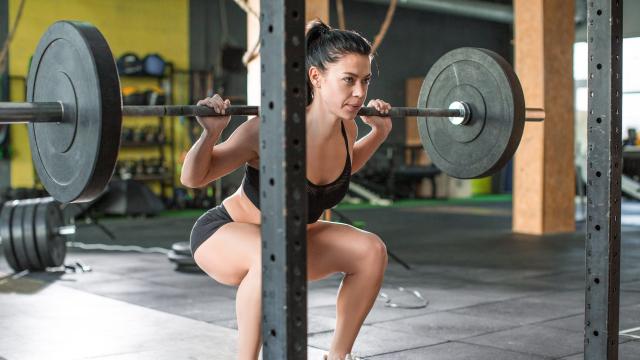There’s a right and a wrong direction to face when you’re squatting.
I know, I know — I’m famously tolerant of all different types and styles of lifting. I’ve told you that it’s ok to squat arse-to-grass or to even stay above parallel in some cases. But when it comes to using a squat rack, there is a forwards and a backwards, and it’s time you learned which is which.
So here’s the big secret: you face toward the hooks of the squat rack when you’re squatting. Here’s the step-by-step:
- You approach the squat rack from the side that the barbell is on. You put your hands on the barbell, duck your head underneath, and stand up with the bar on your shoulders.
- You take a few steps backwards.
- You do your squats.
- Then you walk forwards until your barbell contacts the uprights of the squat rack, and slide it downwards onto the hooks.
- The weight now back on the rack, you extract your head and shoulders and back away from the squat rack, only to repeat the process in another three to five minutes when you’re rested.
Why the direction of your squat rack matters
Why does it matter? Well, think about how you’re going to safely re-rack the bar when you’re exhausted after a set of heavy squats. If you followed my instructions, the rack is right in front of you. You can see where it is, where the hooks are, and put the bar where it needs to go.
If you did the opposite, and approached the bar from behind the squat rack, you’ll finish your set and then need to back into the rack. You don’t know exactly how far it is behind you, and you can’t safely turn your neck to look behind you with 200 (or whatever) pounds on your back. You’re a lot more likely to miss the hooks, slam into the rack, or otherwise risk an experience that may be anywhere from annoying to mildly injurious.
There’s another plus, if you’re training with a rack that doesn’t have safeties. At weightlifting gyms and CrossFit boxes, it’s typical to use bumper plates and not bother with safeties (which, despite the name, is totally fine from a safety perspective). In this case, if you go down into a squat and can’t get the bar back up, you just dump it on the floor behind you. No biggie. (There’s a video of me doing exactly this here.)
This isn’t a problem if the squat rack is in front of you; hopefully you made sure that no people or obstacles are on the floor behind you. But if the squat rack is behind you…do you know exactly how far behind? Is there enough room to bail? Don’t put yourself in a position where you’re asking yourself this question. Approach the squat rack correctly in the first place.

Leave a Reply
You must be logged in to post a comment.